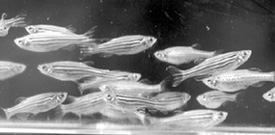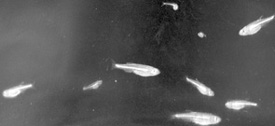
| T H E N I H C A T A L Y S T | M A R C H - A P R I L 1 9 9 8 |
|
LIKEFISH TO WATER, ZEBRAFISH TAKE TO NEW HOME
|
|

| |
|
|
The zebrafish darted gracefully through the waters of their new home in Building 6B as about 75 people who attended the ribbon-cutting ceremony and tour gazed in wonder at their striped sleekness and contemplated the wealth of developmental data there for the investigating.
Zebrafish (Danio rerio) have become a popular model for studies of developmental genetics in recent years, thanks to some unique advantages over other experimental animals.
For example, unlike Drosophila, the zebrafish are vertebrates and follow typical vertebrate development. Unlike higher organisms, however, zebrafish have transparent eggs and embryos, providing a clear, unobstructed view of many developmental processes.
Moreover, zebrafish are comparatively easy and inexpensive to keep and easy to spawn, and they produce large numbers of offspring.

| |
|
| |
 |
By studying mutations in the zebrafish embryos, researchers can identify the earliest expression of those genes associated with cardiovascular, gastrointestinal, neurological, and other structural defects--and search for counterparts in human developmental disorders.
NICHD researchers are currently investigating three areas of development. One focus is on a zebrafish mutation known as "gridlock," in which the two aorti fail to merge properly during development. This defect mimics the human birth defect known as coarctation of the aorta, which affects one to two in 1,000 births.
Another NICHD research team is investigating a mutation in the so-called "notch" receptor, crucial for getting cells to differentiate. Abnormalities of the notch receptor have been implicated in many human cancers.
A third team is studying a transcription factor that plays a key role in early development of the nervous system.
After the open house, the zebrafish facility assumed typical laboratory and animal facility security precautions, but potential collaborators interested in visiting may contact facility staff.